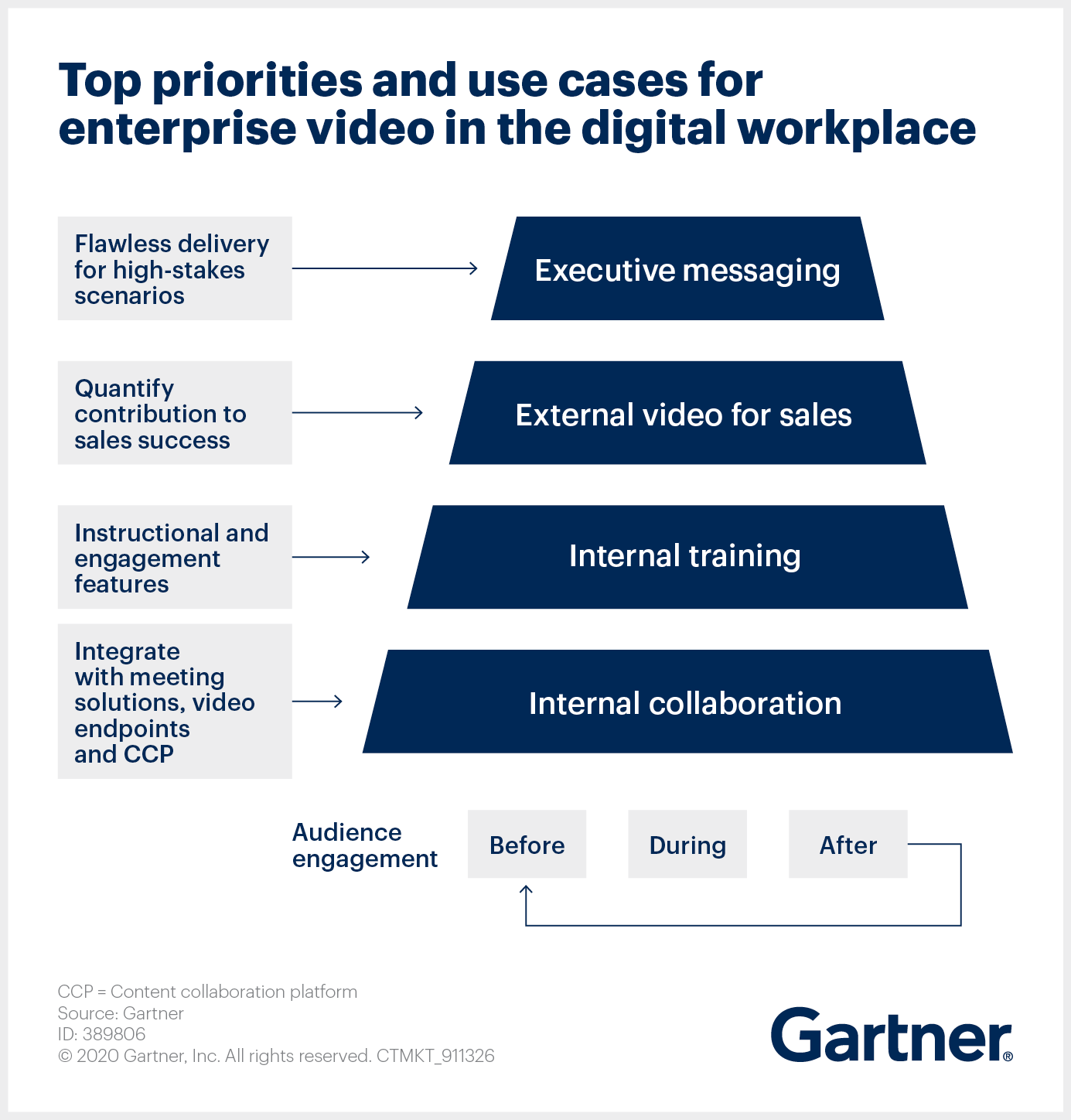Source: Gartner | Contributor: Laura Starita
Live video is the state of the art for executive leaders who want a more engaging and interactive way than audio conferencing to communicate widely and hear feedback from far-flung teams in virtual meetings.
In today’s geographically dispersed workplace, leaders no longer present to employees in the same room at the same time for town halls, all hands and all-company meetings. Yet these large-scale events are essential for executive leaders to share their vision and strategy, address urgent issues and celebrate wins. The solution? Live video.
Companies vary widely in their ability to produce and use high-quality, live video assets in their communications. “There’s a spectrum of engagement,” says Adam Preset, Senior Director Analyst, Gartner. “On one end, you have leaders and teams eager to deliver quality live video events and workers who are able to join and interact in real-time. On the other, you have traditional organizations that are still using massive audio conference bridges to keep people informed at scale.”
The middle of a crisis or other period when people really need to hear from leaders is not the ideal time to figure out a new technology solution
Most organizations are in the middle: they’d like to do more with live video, but they feel ill-equipped to meet audience expectations for engaging content, anywhere consumption and quality production.
To bridge the gap between desire and execution of large video-based meetings, focus on three key areas:
- Preparing virtual meeting content
- Identifying ideal virtual meeting environments
- Procuring virtual meeting talent and technology solutions
1. Preparing virtual meeting content
Large-scale events offer a rare opportunity to send a clear message, but only if leaders carefully hone the content for optimum engagement. On-screen leaders should prepare and practice their talk track so that it sounds polished, but not wooden. Leverage the same presentation techniques that keep in-person audiences engaged, like planned pauses, vocal emphasis and physical gestures. Use images, audio and video clips to complement and illustrate the ideas.
This sounds like a lot of work — and it is. Leaders might be tempted to go instead with voice narration over slide-share images, but the more static approach feels less personal and will promote less engagement.
Leaders should continue to participate on chat, through crowdsourcing and via social channels to hear what people care about
Fortunately, well-prepared, live content encourages audience interaction, which ultimately results in content contributions from the audience. Live video meetings can integrate tools to enable questions from the audience, live polls, real-time chat and live comments — all critical sources of audience interaction and content generation.
“Nor should the interaction end with the close of a live stream,” says Preset. “Leaders should continue to participate on chat, through crowdsourcing and via social channels to hear what people care about after the video event ends.”
2. Identifying ideal virtual meeting environments
In an ideal world, all team members would be able to attend video-based all-company meetings at the same time and/or with everyone in their local office. That’s not always possible in widely dispersed organizations, or in operations that require a portion of the workforce to be on the job during the meeting. As a consequence, live video should be accessible on a range of screen types and though on-demand options to enable people in different work environments and time zones to watch when they’re available.
To accommodate this range, organizations should maximize distribution to as many platforms as possible. Options include desktops, mobile screens, conference room screens, and digital sign boards in common areas or break rooms, among others. Also include audio transcripts to ensure access.
“The environment” also includes the digital environments where employees look for company content. Organizations might push on-demand video content to workstations, or post it to a company website. Other options include posting the video in a messaging application, on social media or in workflow applications.
3. Procuring virtual meeting talent and technology solutions
Quality live video events require the right people and the right technology to execute. Simple events may need only an on-camera leader delivering content, whereas longer events with more segments may require a moderator to balance contributions, manage time, and ensure that questions and feedback are acknowledged. Off-camera teams also seed questions, solve off-screen technical problems and provide audience “service” to ensure the event runs smoothly.
On the technology side, there are two options companies use most often to capture and deliver video for meetings: Meeting software that allows participants to join and watch a live-streamed presentation and enterprise video content management platforms that support live and on-demand delivery for both internal and external audiences. Companies might also post nonconfidential videos to sharing platforms like YouTube or Vimeo, or work with a webcasting company when the goal is to deliver a consumer experience.
The right solution might be the simplest. “The middle of a crisis or other period when people really need to hear from leaders is not the ideal time to figure out a new technology solution,” says Preset.
If you use a meeting solution for small meetings, check whether it can do large-scale ones as well. If you use a platform for training and marketing videos, see if it can do live video as well as on-demand. If you work with a unified communications vendor, service provider or system integrator already, they might have options to help you communicate at scale.





